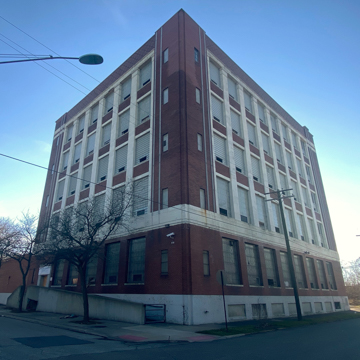The five-story Mazer-Cressman Cigar Company Plant is one of few factories surviving from the era when Detroit rivaled Tampa as the center of America’s cigar industry. To reduce costs of the labor-intensive process of cigar rolling, Mazer-Cressman and other Detroit firms constructed factories in Poletown for proximity to a workforce of Polish immigrant women. Located south of the Dodge Main automobile manufacturing plant, the neighborhood formed the core of the city’s Polish community and hosted parishes, bakeries, and light industry. Designed by Albert Kahn, Inc., the plant was constructed in 1925 over half a block between Theodore and East Warren streets. The new factory, built of “smooth, cherry red brick” and reinforced concrete, embodied the firm’s response to increasing competition from manufacturers hiring in-house engineers for industrial design. In The Western Architect, Moritz Kahn, vice president of the architectural firm and Albert’s brother, argued that factories designed by architects, such as the practice’s own Mazer-Cressman Cigar Company and the Studebaker Assembly Plant, could improve a laborer’s “mental attitude toward his work” through simple decoration and increased lighting, while maintaining cost effectiveness.
The 1937 Cigar Strike in Detroit challenged Kahn’s assumption about male laborers and revealed the limited ability of architecture to improve workers’ well-being. Polish women formed the backbone of the cigar industry and faced discrimination based on gender and ethnicity. The success of the United Automobile Workers’s (UAW) strike in Flint motivated Polish women, who were faced with low pay, sexual harassment, and unsanitary conditions, to begin a sit-down strike at the Webster-Eisenlohr Factory on February 16, 1937. Inspired by the UAW’s Polish radio program, strikers sent a delegation to speak with Stanley Nowak, a Polish immigrant and one of the first organizers hired by the UAW. The busy Nowak initially refused to join, acquiescing only when the women threatened to move their sit-down strike to UAW headquarters.
Within days, the strike spread to 2,500 workers across six factories—Webster-Eisenlohr, Mazer-Cressman, Essex, Tegge Jackson, Bernard Schwartz, and General Cigar. Shared Polish institutions and media enabled organizing even though the workers were not formally affiliated with a union. The Dom Polski (2281 E. Forest Ave.) became a central site for rallies and the Glos Ludowy (“The People’s Voice”) provided sympathetic newspaper coverage. Strikers took three day shifts at the factory, returning home to bathe and prepare food. Many workers were young mothers who passed their infants through factory windows to nurse. There were no beds and only rudimentary kitchens. Strong communal ties were essential to maintaining strike kitchens and keeping workers supplied.
The strike was met with unusually violent resistance. Stanley Nowak and Mary Zuk—a leader of the 1935 Meat Strike and Hamtramck City Councilwoman—fled the General Cigar Company by jumping out a second-story window when management sent men armed with clubs. On March 16, Detroit Police broke into plants still on strike, beating workers and dragging them by the hair out of the premises. Even women watching from porches were not exempt. Anne Rzemkowska, then pregnant, shouted at police to stop beating a man. The policemen clubbed Rzemkowska, leaving her bruised and bleeding on the ground.
The UAW responded in force to the police’s violent escalation. About 200,000 trade unionists rallied on March 24 and demanded that Police Chief Pickert be fired. Following the intervention of Governor Murphy at the behest of the striking women, a federal mediator achieved a resolution on April 7. By late April, the UAW expressed interest in the cigar union and the Committee for Industrial Organizations chartered Cigar Workers Local 24, chaired by Sophie Myszka. While the strike was a success, the heyday of the cigar industry was already over. Mechanization reduced the need for laborers and the popularity of cigars was decreasing. Like Ybor City and other centers of cigar production across the country, by the 1960s, Detroit’s cigar factories shut their doors. In the mid 1980s, the City of Detroit took over the Mazer-Cressman property for use as the Department of Human Services.
References
Associated Press. “Strikers Hold 7 Plants.” Evening Star, February 20, 1937.
Cooper, Patricia A. Once a Cigar Maker: Men, Women, and Work Culture in American Cigar Factories, 1900–1919. Urbana-Champaign: University of Illinois Press, 1987.
Jackowski, John, and Klara Jackowski. Chene Street History Project. Interview by Marian Krzyzowski, September 20, 2002.
“J.W. Rollinson Ad.” The Michigan Architect and Engineer, December 1924.
Kahn, Moritz. “The Design of Industrial Buildings from the Standpoint of the Architect.” The Western Architect, August 1925.
Klin, Alina. Strikes by the Polish Women in the Detroit Cigar Factories. Film. Detroit, MI: Wayne State University, 2016.
Nowak, Margaret Collingwood. Two Who Were There: A Biography of Stanley Nowak. Detroit, MI: Wayne State University Press, 1989.
Tariff Act of 1929: Schedule 6, Tobacco and Manufactures of, Pub. L. No. 63310, § Subcommittee of the Committee on Finance (1929). https://www.finance.senate.gov/imo/media/doc/71HrgVolVI.pdf.














